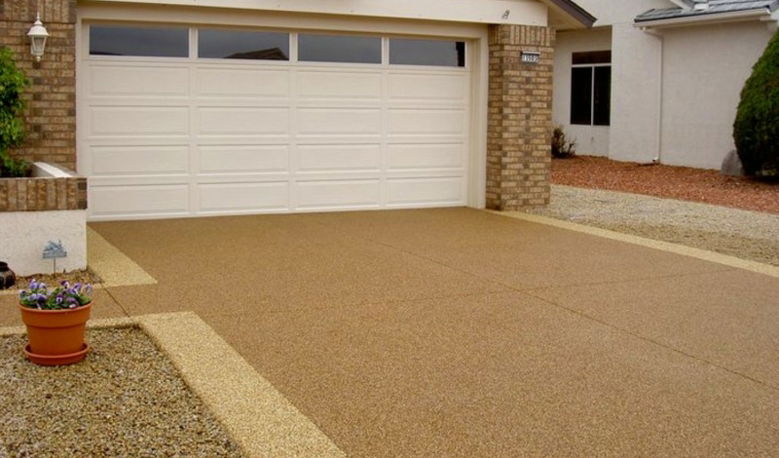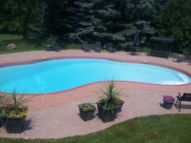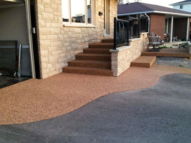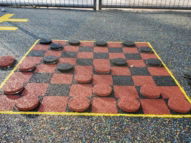Quick Links: Introduction | 5 Reasons for Rubber Stone | The Process | Comparison
Rubber stone resurfacing is a smart and eco-friendly way to refresh your outdoor surfaces. Ideal for homeowners in Illinois and Indiana.
Whether you want to repair a driveway, upgrade your patio, or create a safer walkway, rubber stone resurfacing offers a strong and long-lasting alternative to traditional concrete and asphalt. It provides excellent traction for safety in wet conditions and comes in a variety of colors and textures to fit your style.
This low-maintenance option is resistant to cracks, fading, and chiping, making it a great long-term investment. Plus, it can handle extreme hot and cold weather much better than traditional surfacing options.
Contact us for a quote or scroll down or click the options above this section to see how rubber stone resurfacing can enhance your property, improve curb appeal, and provide a lasting solution for your resurfacing needs!

5 Reasons to Choose Rubber Stone
Rubber stone is an excellent choice for resurfacing for several reasons:
- Durability: Rubber stone is built to last. It can withstand heavy traffic, making it perfect for driveways and patios. Unlike traditional surfaces, it won't easily crack or break.
- Slip Resistance: Safety is a top priority. Rubber stone provides a textured surface that helps prevent slips and falls, especially when wet. This makes it a great option for pool decks and walkways.
- Aesthetic Appeal: With a wide range of colors and textures, rubber stone can enhance the look of your home. You can customize it to match your style and landscaping, giving your outdoor spaces a fresh, modern feel.
- Eco-Friendly: Made from recycled materials, rubber stone is an environmentally friendly option. Choosing this surface not only benefits your home but also helps the planet.
- Low Maintenance: Once installed, rubber stone requires minimal upkeep. It’s easy to clean and doesn’t need sealing like concrete, saving you time and money.
The Rubber Stone Resurfacing Process
Understanding the rubber stone resurfacing process can help you feel confident about your decision. Here’s a step-by-step breakdown of what to expect during installation:
- Initial Assessment: A professional will evaluate your current surface to determine its condition and suitability for Rubber Stone. This assessment helps identify any necessary repairs or preparation.
- Surface Preparation: The existing surface will be cleaned thoroughly to remove dirt, debris, and any loose materials. Cracks and uneven surfaces will be covered in the process.
- Applying Rubber Stone: The rubber/epoxy mixture is troweled on to create a smooth, even finish.
- Curing Time: Once the application is complete, the resurfaced area needs time to cure. This usually takes about 24 to 48 hours, depending on weather conditions. During this time, it’s important to avoid foot and vehicle traffic on the surface. After 48 hours, your surface is ready to use again!
Comparing Traditional Resurfacing Options
As you are looking at resurfacing options, you need to understand how Rubber Stone compares to other materials like concrete, asphalt, pavers and stone. Here's a quick overview:
Durability
Rubber Stone: Highly durable and resistant to cracking, fading, and chipping. It can handle heavy traffic and extreme weather conditions.
Concrete: While strong, concrete can crack over time and may require sealing to maintain its appearance.
Asphalt: Generally less durable than rubber stone and may need regular maintenance, such as resealing and patching.
Stone & Pavers: Durable but can shift and settle over time, leading to uneven surfaces.
Safety
Rubber Stone: Offers excellent slip resistance, making it a safe choice for pool decks and walkways.
Concrete/Asphalt: Can be slippery when wet, posing a safety risk.
Stone & Pavers: Provide some traction, but the gaps between pavers can accumulate water, which may create slippery conditions.
Curb Appeal
Rubber Stone: Available in a variety of colors and textures, allowing for customization to match your home’s style.
Concrete: Limited design options unless stamped or stained, which can increase costs.
Asphalt: Generally has a basic appearance, though it can be colored with special treatments.
Stone & Pavers: Highly customizable with various shapes and colors, but can be more expensive.
Maintenance
Rubber Stone: Low maintenance; easy to clean and does not require sealing.
Concrete: Requires regular sealing and cleaning to prevent stains and damage.
Asphalt: Needs resealing every few years and is more prone to oil stains.
Stone & Pavers: Require regular maintenance to prevent weed growth in joints and may need replacement if damaged.
Cost
Rubber Stone: Initial investment may be higher, but its durability and low maintenance can save money in the long run.
Concrete: Generally lower upfront costs but may incur higher long-term maintenance expenses.
Asphalt: Usually cheaper to install, but maintenance costs can add up over time.
Stone & Pavers: Higher initial costs, but can offer excellent longevity and aesthetics.
HOURS
Mon to Fri
Weekends
7 AM - 5 PM
CLOSED
SITE NAVIGATION
AREAS SERVED
Indiana
Crown Point, St. John, Munster, Schererville, and Valparaiso
Illinois
Cook County, Kankakee County, Will County







